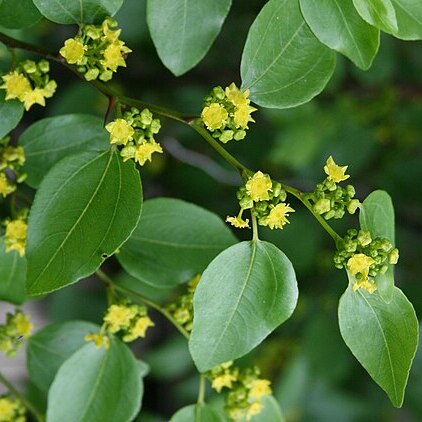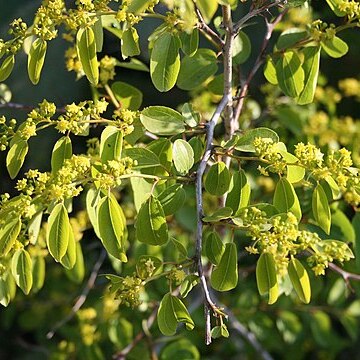Trees or shrubs, small to medium-sized, evergreen or deciduous. Leaves alternate, 3-veined from base, margin subentire to serrate; stipules usually changed into 1 or 2 lignified, erect or revurved spines. Flowers bisexual, 5-merous, perigynous, few to many in axillary, pedunculate cymes. Pedicel short, often elongated in fruit. Calyx tube hemispheric to dish-shaped; sepals free, deltoid, 1.5-2.5 × 1.5-2.5 mm, abaxially ± pubescent to glabrous, adaxially keeled, apex acute to weakly acuminate. Petals spatulate or unguiculate,1-2 mm, often enfolding stamens. Stamens free, 1.5-2 mm; filaments subulate, thin; anthers ovoid, latrorse. Disk adnate with calyx tube, pentagonal or rounded, thick, fleshy, glabrous. Ovary semi-inferior, 2-or 3-loculed, with 1 ovule per locule, slightly immersed in disk; style cylindric or flattened, with 2 or 3 ± diverging stylar branches. Fruit a dry, indehiscent, disk-to cup-shaped or hemispheric, winged drupe, base ± distinctly conical, often with remains of calyx tube, apex rounded to ± flattened; mesocarp leathery to corky; endocarp lignified. Seeds brownish, shiny, obovoid to ovoid; endosperm scanty, cotyledons flat.
More
Shrubs [or trees], sometimes clambering, armed with stipular spines; bud scales present. Leaves deciduous [persistent], alternate; blade not gland-dotted; 3-veined from base (acrodromous), secondary veins distal to basal veins well developed. Inflorescences axillary, cymes; peduncles and pedicels not fleshy in fruit. Pedicels present. Flowers bisexual; hypanthium hemispheric to patelliform, 2–3 mm wide; sepals 5, spreading, pale yellow, deltate, keeled adaxially; petals 5, white, hooded, obovate, clawed; nectary fleshy, filling hypanthium, margin entire or 5-angled; stamens 5; ovary 1/2-inferior, 2–3-locular; styles 2–3, connate proximally. Fruits samaras. x = 12.


